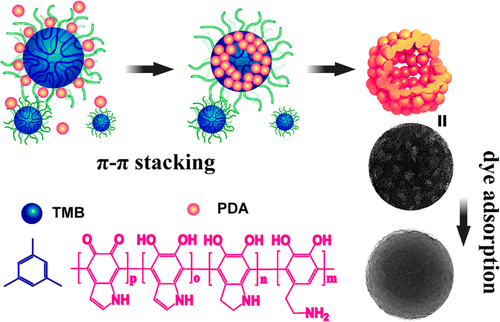Our official English website, www.x-mol.net, welcomes your
feedback! (Note: you will need to create a separate account there.)
Nanoscale Polydopamine (PDA) Meets π–π Interactions: An Interface-Directed Coassembly Approach for Mesoporous Nanoparticles
Langmuir ( IF 3.7 ) Pub Date : 2016-11-10 00:00:00 , DOI: 10.1021/acs.langmuir.6b03294 Feng Chen 1 , Yuxin Xing 1 , Zhenqiang Wang 1 , Xianying Zheng 1 , Jixi Zhang 1 , Kaiyong Cai 1
Langmuir ( IF 3.7 ) Pub Date : 2016-11-10 00:00:00 , DOI: 10.1021/acs.langmuir.6b03294 Feng Chen 1 , Yuxin Xing 1 , Zhenqiang Wang 1 , Xianying Zheng 1 , Jixi Zhang 1 , Kaiyong Cai 1
Affiliation

|
Well known for the adhesive property, mussel-inspired polydopamine (PDA) has been shown to enhance performance in a wide range of adsorption-based applications. However, imparting porous nanostructures to PDA materials for enhanced loading capacities has not been demonstrated even when surfactants were present in the synthesis. Herein, we report on the preparation of mesoporous PDA particles (MPDA) based on the assembly of primary PDA particles and Pluronic F127 stabilized emulsion droplets on water/1,3,5-trimethylbenzene (TMB) interfaces. The key to the formation of this new type of the MPDA structure is the full utilization of the π–π stacking interactions between PDA structures and the π-electron-rich TMB molecules. Remarkably, this method presents a facile approach for MPDA particles with an average diameter of ∼90 nm, slit-like pores with a peak size of ∼5.0 nm as well as hollow cavities. When used as the adsorbent for a model dye RhB, the MPDA particles achieved an ultrahigh RhB adsorption capacity of 1100 μg mg–1, which is significantly higher than that for the PDA-reactive dyes with Eschenmoser structure. Moreover, it was demonstrated that the cavity space in MPDA can facilitate high volumetric uptake in a capillary filling/stacking manner via the π–π interactions. These developments pave a new avenue on the mechanism and the designed synthesis of functional PDA materials by organic–organic composite assembly for advanced adsorption applications.
中文翻译:

纳米级聚多巴胺(PDA)满足π–π相互作用:介孔纳米粒子的界面定向共组装方法
贻贝启发性聚多巴胺(PDA)以其粘合性能而闻名,在多种基于吸附的应用中已显示出增强的性能。然而,即使在合成物中存在表面活性剂时,也没有证明将多孔纳米结构赋予PDA材料以提高负载能力。本文中,我们基于水/ 1,3,5-三甲基苯(TMB)界面上的主要PDA颗粒和Pluronic F127稳定的乳液液滴的组装情况,报告了介孔PDA颗粒(MPDA)的制备。形成这种新型MPDA结构的关键是充分利用PDA结构与富含π电子的TMB分子之间的π-π堆积相互作用。值得注意的是,这种方法为平均直径约为90 nm的MPDA颗粒提供了一种简便的方法,狭缝状的孔,峰值大小约为5.0 nm,还有中空的孔洞。当用作模型染料RhB的吸附剂时,MPDA颗粒实现了1100μgmg的超高RhB吸附能力–1,明显高于具有Eschenmoser结构的PDA反应性染料。此外,还证明了MPDA中的空腔空间可以通过π-π相互作用以毛细管填充/堆积方式促进高体积吸收。这些进展为通过有机-有机复合组装为先进的吸附应用提供功能性PDA材料的机理和设计合成方法开辟了一条新途径。
更新日期:2016-11-10
中文翻译:

纳米级聚多巴胺(PDA)满足π–π相互作用:介孔纳米粒子的界面定向共组装方法
贻贝启发性聚多巴胺(PDA)以其粘合性能而闻名,在多种基于吸附的应用中已显示出增强的性能。然而,即使在合成物中存在表面活性剂时,也没有证明将多孔纳米结构赋予PDA材料以提高负载能力。本文中,我们基于水/ 1,3,5-三甲基苯(TMB)界面上的主要PDA颗粒和Pluronic F127稳定的乳液液滴的组装情况,报告了介孔PDA颗粒(MPDA)的制备。形成这种新型MPDA结构的关键是充分利用PDA结构与富含π电子的TMB分子之间的π-π堆积相互作用。值得注意的是,这种方法为平均直径约为90 nm的MPDA颗粒提供了一种简便的方法,狭缝状的孔,峰值大小约为5.0 nm,还有中空的孔洞。当用作模型染料RhB的吸附剂时,MPDA颗粒实现了1100μgmg的超高RhB吸附能力–1,明显高于具有Eschenmoser结构的PDA反应性染料。此外,还证明了MPDA中的空腔空间可以通过π-π相互作用以毛细管填充/堆积方式促进高体积吸收。这些进展为通过有机-有机复合组装为先进的吸附应用提供功能性PDA材料的机理和设计合成方法开辟了一条新途径。





















































 京公网安备 11010802027423号
京公网安备 11010802027423号